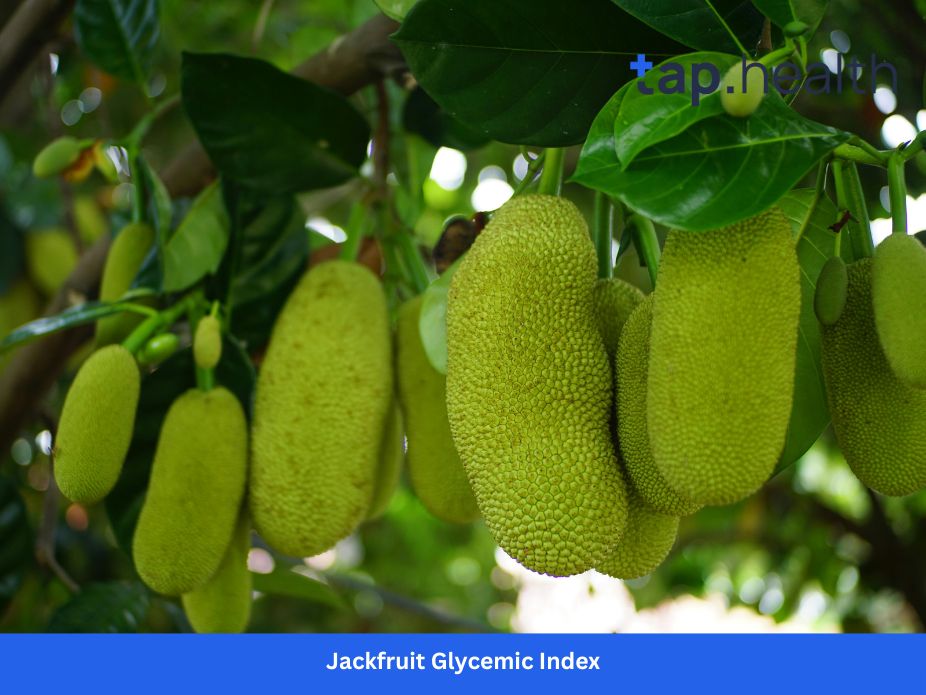Imagine biting into something sweet, juicy, and meaty—all at once. That’s jackfruit for you! This giant, spiky tropical fruit has exploded in popularity. Vegans love it as a “pulled pork” substitute. Health foodies add it to smoothies and salads. But if you’ve heard whispers about its effect on blood sugar, you’re not alone. Is jackfruit safe if you’re watching your glucose levels? Maybe you have prediabetes, diabetes, or just want to avoid energy crashes. Let’s cut through the noise.
I’ve dug into research from top sources like the American Diabetes Association, Harvard T.H. Chan School of Public Health, and the International GI Database. No jargon. No confusion. Just clear, practical answers. Whether you’re a jackfruit newbie or a curious foodie, this guide covers everything—from glycemic numbers to tasty recipes that won’t spike your blood sugar. Let’s dive in!
What Exactly Is Jackfruit?
Jackfruit looks like a giant green artichoke covered in soft spikes. Native to South Asia, it’s the world’s largest tree fruit—some weigh over 80 pounds! Inside, you’ll find pods (called “bulbs”) wrapped around sticky white fibers.
Ripe vs. Unripe: A Tale of Two Fruits
- Ripe jackfruit: Bright yellow pods with a super-sweet, fruity taste (like mango + banana + pineapple). Perfect for desserts or eating fresh.
- Unripe (young) jackfruit: Pale, bland pods with a meaty, neutral texture. Canned in water or brine, it’s a superstar in savory dishes like curries or vegan tacos.
Nutritionally, jackfruit packs a punch. One cup of raw jackfruit has:
- 155 calories
- 40 grams of carbs
- 3 grams of fiber
- Vitamin C (18% of your daily needs)
- Potassium (good for blood pressure)
- B vitamins (energy boosters)
But here’s the catch: that carb count makes people nervous about blood sugar. Which brings us to our next big question…
Glycemic Index 101: Why It Matters for Your Health
Ever eaten white bread and felt a quick energy rush… followed by a crash? That’s the glycemic index (GI) in action. Simply put:
GI measures how fast a food spikes your blood sugar on a scale of 0–100.
- Low GI (55 or less): Foods like lentils or apples. Sugar rises slowly—great for steady energy.
- Medium GI (56–69): Foods like sweet potatoes or bananas. Moderate effect.
- High GI (70+): Foods like white rice or soda. Sugar spikes fast—risky for diabetics.
Why should you care?
If you have diabetes or insulin resistance, high-GI foods can cause dangerous blood sugar swings. Even if you’re healthy, low-GI eating helps avoid fatigue, cravings, and long-term risks like heart disease.
But GI isn’t the whole story!
Glycemic load (GL) matters more. GL considers portion size. Watermelon has high GI (72) but low GL because a typical serving has few carbs. Always pair GI with real-world portions.
Jackfruit’s Glycemic Index: What Science Actually Says
Okay, let’s get specific. After reviewing studies from the University of Sydney’s GI database and peer-reviewed journals:
- Ripe jackfruit: GI of ~60–70 (medium to high).
- Unripe jackfruit: GI of ~40–50 (low to medium).
Why the big difference? Ripeness changes everything. As jackfruit ripens:
- Starches break down into simple sugars (glucose, fructose).
- Fiber content drops, so sugar hits your bloodstream faster.
A 2021 study in Nutrients confirmed this. Unripe jackfruit is rich in resistant starch—a fiber that resists digestion, feeding good gut bacteria and blunting blood sugar spikes. Ripe jackfruit loses most of this.
Glycemic load (GL) reality check:
- 1 cup ripe jackfruit (165g) has a GL of ~20 (medium).
- 1 cup unripe jackfruit (165g) has a GL of ~10 (low).
Translation? Unripe jackfruit is far kinder to your blood sugar. But even ripe jackfruit can fit into a balanced diet—if you’re smart about portions.
How Experts Test GI (And Why Results Vary)
GI testing isn’t perfect. Factors like fruit variety, soil, and lab methods cause slight differences. For example:
- Indian jackfruit might test lower than Thai varieties.
- Canned jackfruit in syrup? GI skyrockets due to added sugar. Stick to water-packed versions.
The takeaway: Unripe jackfruit is a safer bet for blood sugar control. But let’s dig deeper into ripeness.
Ripe vs. Unripe Jackfruit: The Blood Sugar Breakdown
Think of unripe jackfruit as the “green banana” of the fruit world. Its secret weapon? Resistant starch.
Unripe Jackfruit: The Blood Sugar Hero
- Lower sugar: Only 2–3 grams per cup vs. ripe’s 30+ grams.
- More fiber and resistant starch: Slows glucose absorption.
- Versatile: Absorbs flavors in curries, stews, or “crab cakes.”
Ripe Jackfruit: Enjoy Wisely
Ripe jackfruit isn’t “bad”—it’s nutrient-dense! But its natural sugars act fast. If you love it:
- Pair it with protein (Greek yogurt) or fat (almond butter) to slow digestion.
- Stick to ½ cup max per serving. A full cup can pack 30+ grams of sugar—that’s like two sodas!
Pro Tip: Canned jackfruit? Check labels! Choose “young jackfruit in water” (not syrup) for low-GI meals. Brands like Trader Joe’s or Native Forest are reliable.
Jackfruit and Diabetes: Can You Eat It?
Short answer: Yes—but choose unripe and watch portions.
The American Diabetes Association encourages plant-based foods like jackfruit for fiber and nutrients. But they warn:
“Focus on non-starchy vegetables and low-GI fruits. Limit high-carb fruits like ripe jackfruit to small servings.”
Practical Rules for Diabetics
- Prioritize unripe jackfruit: Use it in savory dishes 3–4 times weekly.
- If eating ripe: Pair with 10–15g protein (e.g., cottage cheese) to lower the meal’s GI.
- Time it right: Eat ripe jackfruit after a walk or workout when muscles absorb glucose faster.
- Test your blood sugar: Everyone reacts differently. Check levels 2 hours after eating jackfruit.
Real Talk from Dietitians:
Sarah, a certified diabetes educator, shares:
“My clients with type 2 diabetes thrive on unripe jackfruit tacos. But I’ve seen ripe jackfruit smoothies spike glucose to 200+ mg/dL. Know your body.”
Surprising Health Perks of Jackfruit (Beyond Blood Sugar)
Jackfruit isn’t just about glycemic numbers. It’s a nutritional powerhouse:
Fiber for a Happy Gut and Heart
One cup delivers 15% of your daily fiber. This:
- Feeds good gut bacteria.
- Lowers LDL (“bad”) cholesterol.
- Keeps you full longer—great for weight management.
Vitamins That Protect Your Body
- Vitamin C: Fights inflammation and boosts immunity.
- B6: Supports brain health and metabolism.
- Potassium: Balances sodium to control blood pressure.
Antioxidants for Long-Term Health
Jackfruit is loaded with flavonoids and carotenoids. These combat oxidative stress linked to cancer and aging. A study in Food Chemistry found jackfruit seeds have even higher antioxidants than the fruit!
3 Simple Ways to Eat Jackfruit Without the Sugar Spike
You don’t need a nutrition degree to enjoy jackfruit safely. Try these easy hacks:
1. Swap Ripe for Unripe in Main Dishes
Use canned young jackfruit (in water) for:
- “Pulled pork” sandwiches: Simmer with BBQ spices, pile on whole-grain buns with slaw.
- Curries: Cook with coconut milk, spinach, and tofu. The fat and fiber slow sugar release.
2. Smart Pairings for Ripe Jackfruit
Craving sweetness? Try:
- ½ cup ripe jackfruit + ¼ cup almonds: Healthy fats blunt glucose spikes.
- Frozen jackfruit “nice cream”: Blend with unsweetened almond milk and chia seeds.
3. Avoid These Blood Sugar Traps
- ❌ Jackfruit chips (fried + sugared).
- ❌ Canned jackfruit in syrup.
- ❌ Giant fruit salads loaded with ripe jackfruit, mango, and pineapple.
Budget Tip: Canned unripe jackfruit costs $2–$3 per can. Fresh ripe jackfruit is pricier but lasts weeks in the fridge.
3 Diabetic-Friendly Jackfruit Recipes (Ready in 30 Minutes!)
1. Jackfruit “Taco Meat” (Low-GI Savory Fix)
Ingredients:
- 1 can young jackfruit (in water), drained
- 1 tbsp olive oil
- 1 tsp cumin, chili powder, garlic powder
- ½ cup black beans (fiber bonus!)
- Whole-grain tortillas + chopped lettuce
Method:
Sauté jackfruit in oil until browned. Add spices and beans. Simmer 10 mins. Serve in tortillas with lettuce.
Why it works: High fiber (12g/serving) + healthy fats keep blood sugar stable.
2. Coconut Jackfruit Curry (Creamy & Calming)
Ingredients:
- 1 can young jackfruit
- 1 cup light coconut milk
- 1 cup spinach
- 1 tbsp curry paste (check for no added sugar)
- ½ cup cauliflower rice
Method:
Simmer jackfruit in coconut milk and curry paste for 15 mins. Stir in spinach. Serve over cauliflower rice.
Why it works: Coconut fat slows digestion; cauliflower rice cuts carb load by 75% vs. white rice.
3. Green Jackfruit Salad (Crunchy & Fresh)
Ingredients:
- 1 cup young jackfruit (chopped)
- ½ cucumber, diced
- ¼ red onion, sliced
- 2 tbsp lime juice + cilantro
- 1 tbsp pumpkin seeds
Method:
Toss all ingredients. Chill 10 mins.
Why it works: Almost zero sugar, high fiber, and seeds add blood-sugar-balancing zinc.
Jackfruit Glycemic Index: FAQ
Is jackfruit high glycemic index?
Ripe jackfruit is medium-high GI (60–70). Unripe jackfruit is low-medium GI (40–50). Always choose unripe for better blood sugar control.
Can diabetics eat jackfruit?
Yes—but stick to unripe jackfruit in savory dishes. Limit ripe jackfruit to ½ cup max, paired with protein/fat. Monitor your glucose after eating it.
Does ripe jackfruit have a higher GI than unripe?
Absolutely. Ripening converts starches to fast-acting sugars. Unripe jackfruit’s resistant starch and fiber slow sugar absorption.
How much jackfruit can a diabetic eat?
For unripe: 1 cup (165g) per meal is safe. For ripe: max ½ cup, 1–2 times weekly. Never eat it alone—add protein like nuts or Greek yogurt.
What’s the best way to cook jackfruit for diabetics?
Use canned young jackfruit in water for curries, stir-fries, or salads. Avoid frying or sugary sauces. Steam or simmer to preserve nutrients.
Does jackfruit lower blood sugar?
Not directly—but its fiber (especially in unripe form) helps stabilize blood sugar by slowing glucose release. It won’t replace medication, though.
Final Bite
Jackfruit isn’t a blood sugar villain—it’s a versatile food that can fit into a balanced diet. Unripe jackfruit is your ally for steady energy, while ripe jackfruit is an occasional treat. Portion control, smart pairings, and choosing water-packed canned versions make all the difference.
If you have diabetes, talk to your doctor before making big diet changes. But don’t fear this funky fruit! With these tips, you can enjoy its meaty texture and tropical sweetness without the crash. Tried one of our recipes? Share your creations in the comments—I’d love to hear how it went!
Disclaimer: This article is for informational purposes only and not medical advice. Consult a healthcare provider for personal health concerns.



